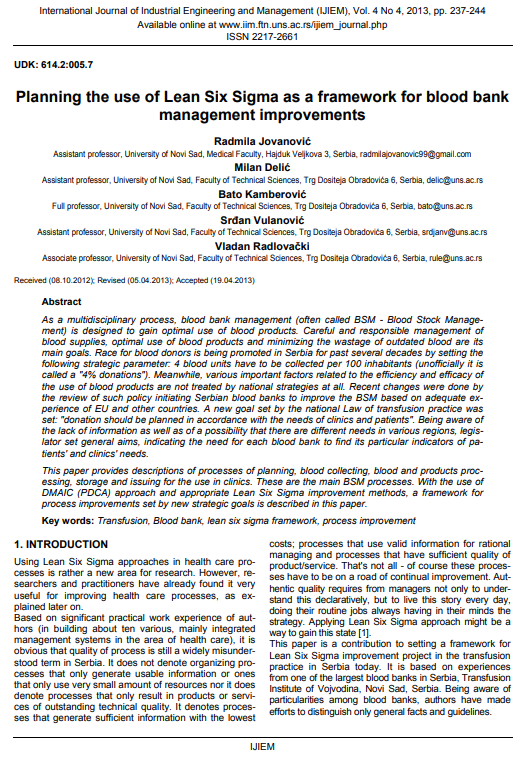Planning the Use of Lean Six Sigma as a Framework for Blood Bank Management Improvements

Published 2013-12-30
abstract views: 86 // FULL TEXT ARTICLE (PDF): 0
Keywords
- Transfusion,
- Blood bank,
- lean six sigma framework,
- process improvement
How to Cite
Copyright (c) 2023 International Journal of Industrial Engineering and Management

This work is licensed under a Creative Commons Attribution 4.0 International License.
Abstract
As a multidisciplinary process, blood bank management (often called BSM - Blood Stock Manage-ment) is designed to gain optimal use of blood products. Careful and responsible management of blood supplies, optimal use of blood products and minimizing the wastage of outdated blood are its main goals. Race for blood donors is being promoted in Serbia for past several decades by setting the following strategic parameter: 4 blood units have to be collected per 100 inhabitants (unofficially it is called a "4% donations"). Meanwhile, various important factors related to the efficiency and efficacy of the use of blood products are not treated by national strategies at all. Recent changes were done by the review of such policy initiating Serbian blood banks to improve the BSM based on adequate ex-perience of EU and other countries. A new goal set by the national Law of transfusion practice was set: "donation should be planned in accordance with the needs of clinics and patients". Being aware of the lack of information as well as of a possibility that there are different needs in various regions, legis-lator set general aims, indicating the need for each blood bank to find its particular indicators of pa-tients' and clinics' needs. This paper provides descriptions of processes of planning, blood collecting, blood and products proc-essing, storage and issuing for the use in clinics. These are the main BSM processes. With the use of DMAIC (PDCA) approach and appropriate Lean Six Sigma improvement methods, a framework for process improvements set by new strategic goals is described in this paper.
Article history: Received (08.10.2012); Revised (05.04.2013); Accepted (19.04.2013)

